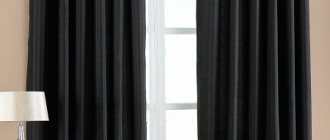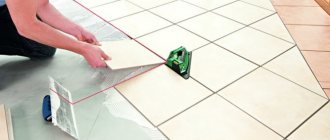How to choose tile grout by color
The main rule: white and beige grout are the 2 most impractical colors. They can only be used for grouting tile joints on the bathroom wall.
White and beige grout is only in the bathroom and only on the wall.
The last photo shows how the pollution rises along the white grout from the floor to the wall.
Algorithm for choosing the color of grout on the floor of the kitchen and hallway : grout in a color 1-2 shades darker than the darkest place on the tile (when the tile is not a single color); or dark gray (anthracite) grout as a universal option. For tile joints on the bathroom floor, match exactly the color of the darkest place on the tile, or the light gray (cement) color of the grout.
The grout in the bathroom should be lighter because the main contamination there is white salt stains from dried water; they are not visible on light gray colors.
For bathroom walls, grout is either exactly the same color, or 1-2 shades lighter, or gray cement color as a universal option. On a wall, grout rarely gets very dirty with anything other than dried water.
If you are too lazy to delve into it, choose a cement-gray grout color - it is the most versatile.
But I still advise you to approach your choice carefully, because... this is not a small thing. Lay out the tiles there too.
Grout color for white tiles
White tiles are the only case when you can use white grout. And then only for walls and outside the kitchen. In the shower area and bathroom, white grout still bears stress; in all other rooms it will lose its appearance very quickly. For floor tiles, even white ones, the use of white fugue is strictly contraindicated in any room.
Even for all-white single-color tiles, it is better to use light gray or beige grout. Visually, it is not much different from white, but it gets dirty significantly less. If for some reason the task is to highlight each specific tile, then you can choose anthracite grout.
In the photo below, 2 different colors were used to grout the tiles at the junctions of the white and gray parts. It is not visible to the naked eye, but know that this is also possible.
Grout color for gray tiles
For gray tiles, the rule for choosing grout color changes slightly: it is better to take gray, but always 1-2 shades darker for both the floor and the walls. For gray, when the color of the grout is darker than the color of the tile, the illusion of additional volume is created. But don't use all-black grout on gray tiles. Although counterintuitive, it is generally much less practical than gray.
By the way, beautiful modern bathrooms now often come in gray - the color is in fashion.
For the bathroom, gray cement-colored grout has proven itself best. Salt stains are not visible on it, and dirty water leaves no traces. The design of bathroom tiles should also be chosen based on considerations of practicality. What to look for when choosing tiles.
Gray tile and gray grout also work best for backsplash tiles.
Grout color for black tiles
You need to be careful when using black tiles. It is definitely not recommended to use black glossy tiles, because... she always looks dirty. The slightest fingerprints and the smallest scratches are visible on it.
Choose black tiles only with texture.
If black tiles are laid on a wall that does not come into contact with water, then the grout should be chosen as black as possible. It looks luxurious, but is only afraid of salt stains from dried water.
If black tiles are laid on the floor, then it is better to use dark gray grout. Water always gets on the floor, at least during the washing process. And the floor is rarely wiped dry. As a result, dark gray grout on the floor looks simply cleaner than black grout. Have you already noticed that this is the main criterion for choosing grout color.
Grout color for colored tiles
If you have colored tiles, then the basic rule stated above applies. When you can’t find a color that suits you, and this often happens despite the wide range of grouts from different manufacturers, choose gray.
It may seem that we too often suggest gray grout. The fact is that this is truly the most practical and versatile color, the choice of which you are unlikely to regret. All other options are some risk.
The main thing with colored grouts is that they are only needed for tiles of the same color. You should never use colored grout on non-colored tiles. It will look terrible. In the photo below there is yellow grout on a white tile and it looks dubious:
By the way, we are in:
What color to choose mosaic grout
For mosaics, the rule for choosing the color of the grout is different: the closer the color of the grout to the color of the mosaic, the better. The point is the number of seams, which is disproportionately greater than that of tiles. If the grout color is significantly different, the result will be ripples in the eyes from too many small details.
But for mosaics, gray grout comes to the rescue. If you have a colored mosaic and you just can’t match the color of the grout for it, just use a gray one that is suitable in saturation. To do this, take several samples of gray fugue (they are available at all points of sale) and apply them to the mosaic. You will know when the brightness is the same.
For mirror and glossy mosaics, the standard grout color is also gray.
Classic version
Like white tiles, clear grout is universal in any case. A kind of classic. If it’s difficult to decide on a color or you can’t find a suitable shade, this is what you need.
Using white grout in combination with the same tiles will completely hide the seams and create the illusion of a monolithic, solid surface. However, this is far from the only area of application. Despite the fact that such a design will look unusual, we will classify it as a traditional approach. The white color of the seams will emphasize the geometry of the surface and highlight each element of the cladding. We are talking about combining dark tiles with white grout. This is a standard solution with any tile.
Emphasizing surface geometry
The disadvantage of this mastic, especially if used on the floor, is rapid contamination. White is vulnerable to stains. Light-colored grout sometimes permanently changes color when exposed to food or cosmetics with coloring pigments. In this case, even thorough cleaning will not help and the joint filling will have to be replaced.
Grout color palette
Different manufacturers have different color palettes. In basic colors like white, several grays and black, they overlap, but in others they differ significantly.
Grout Ceresit colors
The most commonly used grout in the CIS countries is ceresit. They have several types of grout CE 33, CE 40 and CE 25. The most commonly used grout is Ceresit CE 40 and it has the widest range of colors. Ceresite CE 40 holds moisture and minor deformations well, which means it is less likely to crack due to minor shrinkage and vibrations. Quite a good choice, but there are some nuances in the colors.
Everything is clear with neutral colors; you can get an idea about them by looking at the sticker on the jar or bag. But with more complex flowers, for example Jasmine, Crocus, Sahara and some others, strange things happen. The actual color after grouting and drying is not at all similar to what is indicated on the can.
Perhaps they are fundamentally different, perhaps the printing house conveys it poorly, but the fact remains: the choice of Ceresit grout color must be made after a trial application and drying. Yes, this complicates the process somewhat, but it is better to first buy a minimum amount, apply and let it dry, and then buy everything else. How to immediately wipe all the seams, and in fact remain dissatisfied with the resulting color.
Litokol grout colors
The Litokol brand has perhaps the widest range of grout types and color palette. We will mention their epoxy options later, because... they are not very popular due to their high price. But their line of regular grouts deserves attention.
Their Litochrom line includes, among other things, grout in our favorite gray colors in the amount of 4 pieces. We used all 4 in one apartment for different surfaces. There were no problems with them. What is important is that the color of the sticker on the packaging very closely reflects the final color of the seams after drying. Although Ceresit had no problems with the grays either.
Litokol C.10 gray and C.30 pearl gray can be used as basic universal grout colors.
Grout Satin colors
Another popular grout brand. It is used widely and the reviews are generally good. We have no experience working with it, so we’ll just give you a palette of Atlas grout colors.
Kiilto grout colors
Unfortunately, I also have no experience of using it, but I don’t want to invent it. But the Kiilto color palette is quite wide, we’ll just give it here. If you have experience using this or any other grout, please share it in the comments.
Two-component grout
It's very expensive. This type of epoxy grout is not particularly popular due to its price. In addition to the price, it is difficult to apply, difficult to remove excess residue and wash. If you have a decent budget and your builders have experience working with epoxy grouts, then they should be your choice. They are much more resistant to dirt and are not afraid of moisture at all.
And most importantly, epoxy grouts have a huge number of colors. Including all sorts of glosses, sparkles and even options that glow in the dark. The Litokol brand has a wide range of epoxy grouts. But all this is beyond the scope of this article.
Conclusions on what color of grout to use:
- The color of the tiles is darker for the floor and lighter for the walls.
- If you can’t find it in color, then use gray that matches in tone.
- White only for white tiles, only on the walls and not in the kitchen.
Save and share - it will come in handy!
Grouts for building materials: types and photos
The main purpose of grout for cladding is to fill joints to protect the edges of the tiles from moisture and temperature changes. In addition, the grout must perform a decorative function, which can be seen in the photo.
Types of grout used today
- Based on epoxy resins . This method contains a coloring element and substances that ensure the density and hardness of the seam. This composition can be used in rooms with direct sun, it does not fade, stains do not appear on it, and is very elastinous when laying;
- Cement . This grout is based on various additives that help give the mixture the necessary qualities: uniform distribution along the seam, ease of use, homogeneous mass, quick drying. This type of mixture is suitable for seams no larger than 05 cm. In the store you buy this mixture in the form of a powder, which must be diluted with water until it becomes thick sour cream. If the seams in the tiles exceed 0.5 cm, then a cement mixture with the addition of sand is used;
- Silicone . This type is used in large joints to provide insulation from the elements. The main disadvantage of this type is its rapid wear. But when choosing, buyers prefer this particular type for its wide range of colors.











